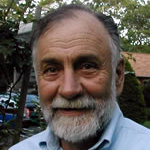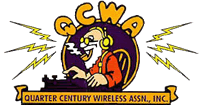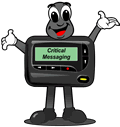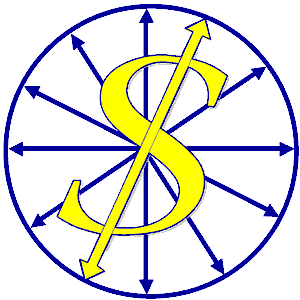

| Wireless News Aggregation |
|
Welcome Back To The Wireless |
|
|||||||
This Week's Wireless Headlines:
|
NO POLITICS HERE This doesn't mean that nothing is ever published here that mentions a US political party—it just means that the editorial policy of this newsletter is to remain neutral on all political issues. We don't take sides.
FREE TO EVERYONE — SUPPORTED BY READERS A new issue of the Wireless Messaging Newsletter is posted on the web each week. A notification goes out by e-mail to subscribers on most Fridays around noon central US time. The notification message has a link to the actual newsletter on the web. That way it doesn’t fill up your incoming e-mail account. There is no charge for subscription and there are no membership restrictions. Readers are a very select group of wireless industry professionals, and include the senior managers of many of the world’s major Paging and Wireless Messaging companies. There is an even mix of operations managers, marketing people, and engineers — so I try to include items of interest to all three groups. It’s all about staying up-to-date with business trends and technology. I regularly get readers’ comments, so this newsletter has become a community forum for the Paging, and Wireless Messaging communities. You are welcome to contribute your ideas and opinions. Unless otherwise requested, all correspondence addressed to me is subject to publication in the newsletter and on my web site. I am very careful to protect the anonymity of those who request it. I spend the whole week searching the INTERNET for news that I think may be of interest to you — so you won’t have to. This newsletter is an aggregator — a service that aggregates news from other news sources. You can help our community by sharing any interesting news that you find.
Editorial Opinion pieces present only the opinions of the author. They do not necessarily reflect the views of any of advertisers or supporters. This newsletter is independent of any trade association. I don't intend to hurt anyone's feelings, but I do freely express my own opinions. |
|||||||
Click on the image above for more info about advertising in this newsletter. |
HELP SUPPORT THE NEWSLETTER
|
|||||||
Subscribe Here — It's Free * required field
|
 |
Advertiser Index
|
Service Monitors and Frequency Standards for Sale
(Images are typical units, not actual photos of items offered for sale here.)
|

|
| Leavitt Communications |
|
|||||||||||||||||||||||||||
Spok Reports Fourth Quarter and Full Year 2022 ResultsFeb 22, 2023 4:10 PM Continued improvement in net income and adjusted EBITDA Company provides financial guidance for the full year 2023 Board Declares Regular Quarterly Dividend ALEXANDRIA, Va.—(BUSINESS WIRE)— Spok Holdings, Inc. (NASDAQ: SPOK), a global leader in healthcare communications, today announced results for the fourth quarter and full year ended December 31, 2022. In addition, the Company’s Board of Directors declared a regular quarterly dividend of $0.3125 per share, payable on March 30, 2023, to stockholders of record on March 16, 2023. Recent Highlights:
"I am proud of what the Spok team has been able to accomplish in 2022 and believe that we have established a solid foundation for the future as we continue to execute our focus on generating cash flow and returning capital to stockholders,” said Vincent D. Kelly, chief executive officer of Spok Holdings, Inc. “Last year, we made progress in several key performance areas, including wireless trends, software bookings and backlog levels, as well as expense management, as we aligned our cost structure with our business plan. In 2023 we will continue to invest in a targeted and limited manner in our Spok Care Connect solutions and leverage the traction that our sales team generated through the 66 six figure new customer contracts booked last year and the growth in our sales pipeline. Spok will also take advantage of new wireless technologies, such as our GenA™ pager, to further minimize unit churn and support average revenue per unit. Going forward, we believe our extensive experience operating our established communication solutions will create significant value for stockholders by maximizing revenue and cash flow generation.” 1) Annual adjusted EBITDA, excluding one-time costs related to the strategic business plan, of $24.5 million is equal to Adjusted EBITDA excluding $7.5 million of payroll and related, and $2.0 million of non-payroll Spok Go and other outside services costs. |
| Source: | Financial Highlights: included at the source | |
| View source version on businesswire.com: https://www.businesswire.com/news/home/20230222005847/en/ | ||
Paging Transmitters 150/900 MHz The RFI High Performance Paging Transmitter is designed for use in campus, city, state and country-wide paging systems. Designed for use where reliable simulcast systems where RF signal overlap coverage is critical.
Built-in custom interface for Prism-IPX ipBSC Base Controller for remote control, management and alarm reporting.

Prism-IPX Systems LLC. 11175 Cicero Dr., Alpharetta, GA 30022
|
The Wireless Messaging News
The Board of Advisor members are people with whom I have developed a special rapport, and have met personally. They are not obligated to support the newsletter in any way, except with advice, and maybe an occasional letter to the editor.
Can You Help The Newsletter?You can help support The Wireless Messaging News by clicking on the PayPal Donate button above. It is not necessary to be a member of PayPal to use this service.
Newspapers generally cost A donation of $50.00 would certainly help cover a one-year period. If you are wiling and able, please click on the PayPal Donate button above . |
|||||||||||||||
| PRISM IPX Systems |
 |
||
Thousands of Users Worldwide Depend on Prism IPXOur Customers Trust Us To Make Sure That Their Messages Get Delivered
|
Cheaper ATSC 3.0 4K TV receivers are coming — with a smart design twistBy Al Griffin published 6 days ago Better broadcast TV at a lower price for any TV, and without using an HDMI port
Hidden among the sprawling booths of the big electronics brands at CES 2023 was a small bunch of displays put on by manufacturers associated with the next-generation digital broadcast TV transition currently taking place in the US. That new digital TV standard, ATSC 3.0 (aka NextGen TV), promises to bring advancements including 4K resolution video with high dynamic range and immersive audio formats such as Dolby Atmos to free, ad-supported broadcast TV. While those capabilities haven’t yet been tapped by the ATSC 3.0 broadcast TV stations operating in 66 US markets, a footprint covering more than 50% of the country, some of the best 4K TVs, including models from Sony, Samsung, LG, and Hisense now feature built-in ATSC 3.0 tuners. CES 2023 turned out to be something of a wash when it came to new TVs with ATSC 3.0 support. Hisense seemed to be the only one championing the format, with its full lineup of 2023 mini-LED TVs slated to get the feature. LG announced that it would appear in the company’s higher-end models like the Z3 and G3 OLED sets — same as in 2022 — and the same goes for Samsung, which will provide the feature in its flagship sets like the new S95C OLED. Sony, meanwhile, has yet to provide detailed specs for its 2023 TV lineup and TCL hasn't announced any new TVs with built-in ATSC 3.0 tuners. The sluggish ATSC 3.0 uptake among TV makers and broadcasters alike is concerning — industry group the National Association of Broadcasters (NAB) recently encouraged the FCC to take proactive steps to accelerate the transition, presumably by amending the requirement for ATSC 3.0 broadcasters to also simulcast programs in the older ATSC 1.0 format for five years after making the transition. Even so, examples of external hardware designed for tuning in NextGen TV broadcasts have emerged. One such example is the ZapperBox M1, a set top box with a built-in ATSC 3.0 tuner that connects to TVs using an HDMI output. But at $250, the M1 likely cost more than most viewers will want to pay to add that capability. Among the companies exhibiting in the NextGen TV booth at CES was Tolka, which is part of broadcast industry group Pearl TV’s FastTrack for NextGen TV program, an initiative aimed at hastening the commercial development of both ATSC 3.0-compatible TVs and inexpensive accessory devices for tuning in NextGen TV broadcasts. The company has created software to power a compact USB stick-type ATSC 3.0 tuner that plugs into a set’s USB port and connects to a TV antenna. Such devices are being made by Atlanta-based company ADTH and should be available at retail later this year for under $75.
Cheap external tuners can accelerate the ATSC 3.0 transitionBroadcast TV has been a consistently popular form of entertainment in the US, even with the onset of cable and satellite and, later on, streaming services. In fact, FAST (free ad-supported TV) apps on smart TVs and streaming platforms like Roku (Roku TV) and Amazon Prime Video (FreeVee), have gained considerable traction, which is a testament to the power of free TV channels. The problem with FAST apps is that the quality is generally bad — certainly less than viewers have come to expect in the 4K era. And while all ATSC 3.0 stations are currently broadcasting in regular HD instead of 4K, a situation partly due to bandwidth limitations created by the FCC’s simulcasting requirement, their ability to deliver higher-quality video and audio is compelling. Imagine being able to tune in sports in 4K — something you currently have to pay for a pricey cable or satellite TV package to experience. That was the case with the recent Super Bowl LVII, which was transmitted in 4K with Dolby Vision HDR, but only by cable provider Comcast Xfinity. Pearl TV’s FastTrack for NextGen TV program can help make free 4K sports and other programs happen by not just ensuring more new TVs coming to market are ATSC 3.0 compatible, but inexpensive external solutions such as ADTH’s forthcoming USB tuner become widely available so that older, ATSC 1.0-only TVs can make the upgrade. A much broader ATSC 3.0 tuner base can only help float the ATSC 3.0 broadcasting boat.
ADTH’s Tolka-powered USB tuner solution seems to be an especially good one, and not just because it’s cheap. Using the set’s USB port for tuning digital TV broadcasts will free up HDMI ports on the set for connecting the best 4K blu-ray players, XBox Series X or PlayStation 5 game consoles, and the best soundbars, and it eliminates the need for an external set top box. Free ad-supported broadcast TV has life left in it — as long as manufacturers keep making TV antennas, viewers will be buying them and plugging them into their sets. But it’s time for the broadcasting industry to make a big leap forward in quality to keep pace with streaming services, and that’s something only a more rapid and complete transition to ATSC 3.0 can make happen.
|
||||
| Source: | Tech Radar |
| Easy Solutions |
Providing Expert Support and Service Contracts for all Glenayre Paging Systems.The GL3000 is the most prolific paging system in the world and Easy Solutions gladly welcomes you to join us in providing reliable support to the paging industry for many more decades in the future. Easy Solutions provides cost effective computer and wireless solutions at affordable prices. We can help in most any situation with your communications systems. We have many years of experience and a vast network of resources to support the industry, your system and an ever changing completive landscape.
Experts in Paging Infrastructure
Please see our web site for exciting solutions designed specifically for the Wireless Industry. We also maintain a diagnostic lab and provide important repair and replacement parts services for Motorola and Glenayre equipment. Call or Easy Solutions |
| Readers of the Newsletter who are Ham Radio Operators |
|
| Source: | Amateur Radio callsigns of readers. Please click here to add yours. |
GLENAYRE INFRASTRUCTUREService ContractsI would like to recommend Easy Solutions for Support of all Glenayre Paging Equipment. This Texas company is owned and operated by Vaughan Bowden. I have known Vaughan for over 35 years. Without going into a long list of his experience and qualifications, let me just say that he was the V.P. of Engineering at PageNet which was—at that time—the largest paging company in the world. So Vaughan knows Paging. GTES is no longer offering support contracts. GTES was the original group from Vancouver that was setup to offer support to customers that wanted to continue with the legacy Glenayre support. Many U.S. customers chose not to use this service because of the price and the original requirement to upgrade to version 8.0 software (which required expensive hardware upgrades, etc.). Most contracts ended as of February 2018. If you are at all concerned about future support of Glenayre products, especially the “king of the hill” the GL3000 paging control terminal, I encourage you to talk to Vaughan about a service contract and please tell him about my recommendation. Click on the image above for more info about advertising here. |
INTERNET Protocol Terminal The IPT accepts INTERNET or serial messaging using various protocols and can easily convert them to different protocols, or send them out as paging messages. An ideal platform for hospitals, on-site paging applications, or converting legacy systems to modern protocols.
Additional/Optional Features
Prism-IPX Systems LLC. 11175 Cicero Dr., Alpharetta, GA 30022 |
||||||||||||||||||||||||||||||
Paging Data Receiver PDR-4 The PDR-4 is a multi-function paging data receiver that decodes paging messages and outputs them via the serial port, USB or Ethernet connectors. Designed for use with Prism-IPX ECHO software Message Logging Software to receive messages and log the information for proof of transmission over the air, and if the data was error free.
Prism-IPX Systems LLC. 11175 Cicero Dr., Alpharetta, GA 30022 |
Wireless Network Planners
|
|||||||||||
R.H. (Ron) Mercer |
 |
| Telephone: 631-786-9359 | |
| wirelessplannerron@gmail.com |
|
|
|
|
Apple Watch a step closer to ban in the United States after President Biden upholds rulingBy John-Anthony Disotto published 3 days ago The end is nigh, or is it?
The Apple Watch is one step closer to a ban in the United States after President Biden’s administration upheld Apple’s infringements. As of today, the International Trade Commission’s Limited Exclusion Order (LEO) on Apple Watches infringing on AliveCor, a medical device company, patents became the first-ever LEO against Apple to clear Presidential review. This news follows on from the ITC’s ruling in December that the Apple Watch infringes AliveCor patents regarding the electrocardiogram technology used in Apple’s latest smartwatches. The ITC also ruled on a cease and desist order, which if enforced, would prevent Apple from importing any Apple Watch into the United States for sale. Responding to the confirmation of the Presidential review clearance, Priya Abani, CEO of AliveCor. said, “We applaud President Biden for upholding the ITC's ruling and holding Apple accountable for infringing the patents that underpin our industry-leading ECG technology,” "This decision goes beyond AliveCor and sends a clear message to innovators that the U.S. will protect patents to build and scale new technologies that benefit consumers." So long, dear friendThis now means that we have reached an unprecedented stage of a small company going against a huge powerhouse in the tech industry like Apple. With the decision of The White House to not intervene and prevent the ITC’s ruling from progressing there is a real possibility that the Apple Watch is banned in the United States. The LEO will go into effect upon resolution of all appeals in the case, including AliveCor’s appeal of the U.S. Patent Trial and Appeal Board’s decision that found the asserted patents unpatentable. This means that there are still twists and turns to this story as Apple is likely to use its seemingly unlimited lobbying power to protect Apple Watch sales in the U.S. We’ll be watching with a huge interest in the coming weeks as the future of Apple’s immensely popular smartwatches comes under severe threat.
|
||||
| Source: | iMore |
Brad Dye, Ron Mercer, Allan Angus, and Ira Wiesenfeld are friends and colleagues who work both together and independently, on wireline and wireless communications projects. Click here Note: We do not like Patent Trolls, i.e. “a person or company who enforces patent rights against accused infringers in an attempt to collect licensing fees, but does not manufacture products or supply services based upon the patents in question.” We have helped some prominent law firms defend their clients against this annoyance, and would be happy to do some more of this same kind of work. Some people use the title “consultant” when they don't have a real job. We actually do consulting work, and help others based on our many years of experience. “If you would know the road ahead, ask someone who has traveled it.” — Chinese Proverb
|
Remote AB Switches ABX-1 switches are often used at remote transmitter sites to convert from old, outdated and unsupported controllers to the new modern Prism-IPX ipBSC base station controllers. Remotely switch to new controllers with GUI commands. ABX-1 ABX-3 switches are widely used for enabling or disabling remote equipment and switching I/O connections between redundant messaging systems. ABX-3 Common Features:
Prism-IPX Systems LLC. 11175 Cicero Dr., Alpharetta, GA 30022 |
NASA HELP WANTED: HAM RADIO OPERATORS PLEASE APPLYby: Al Williams February 23, 2023
NASA’s been recruiting citizen scientists lately, and their latest call is looking for help from ham radio operators. They want you to make and report radio contacts during the 2023 and 2024 North American eclipses. From their website:
The upcoming eclipses are in October of this year and in April 2024, so you have some time to get your station in order. According to NASA, “It will be a fun, friendly event with a competitive element.” So if you like science, space, or contesting, it sounds like you’ll be interested. Right now, the big event is the Solar Eclipse QSO Party. There will also be a signal spotting challenge and some measurements of WWV, CHU, AM broadcast stations, and measurements of the ionosphere height. There will also be some sort of very low-frequency event. Details on many of these events are still pending. Hams, of course, have a long history of experimenting with space. They routinely bounce signals off the moon. They also let radio signals bounce off the trails of ionized gas behind meteors using special computer programs. |
| Source: | hackaday |
| Leavitt Communications |
|
|||||||
| Inside Towers Newsletter |
Rosenworcel Proposes Rules to Block “Likely Illegal” RobotextsFCC Chairwoman Jessica Rosenworcel proposed new rules to protect consumers from text messaging scams. The new rules would require carriers to block certain robotext messages that are “highly likely to be illegal,” says the Commission. The agency plans to vote on the rules in March. “Missing packages that don’t exist; confirmation of payments that didn’t happen; links to shady websites; and truncated ‘wrong number’ messages from strangers. These scam robotexts are a part of everyday life for too many of us,” said Rosenworcel. “I’m asking my colleagues to join me in adopting the first FCC rules to focus on shutting down scam texts.” She called scam texts a “growing consumer threat.” The item proposes to require carriers to block texts from upstream providers that are known to be transmitting illegal robotexts, once notified by the FCC. It also includes blocking of texts carrying invalid, unallocated, or unused numbers. A second rule would require each carrier to make public a single point of contact for text senders. |
| Source: | Inside Towers newsletter | Courtesy of the editor of Inside Towers, Jim Fryer. Inside Towers is a daily newsletter by subscription. |
| BloostonLaw Newsletter |
REMINDER: CPNI, HUBB Certifications Due March 1On March 1, carriers must file their Annual Certification of CPNI Compliance. Our clients can send the original to BloostonLaw in time for the firm to make the filing with the FCC by March 1, if desired. Note: If you file the CPNI certification, you must also file the FCC Form 499-A Telecom Reporting Worksheet by April 1. Also due on March 1 is the annual certification of deployment data filed with USAC's High Cost Universal Broadband (HUBB) portal showing, showing where covered providers built out mass-market, high-speed Internet service in the previous calendar year. Carriers that have no locations to upload must certify this fact in the HUBB. Carriers with 2022 deployment milestones must also complete milestone certifications as part of the annual HUBB filing and will face verification reviews tied to those milestones. BloostonLaw Contacts: Cary Mitchell and Sal Taillefer. HeadlinesFCC Issues Robocall Enforcement Notice to US-Based Voice Service ProvidersOn February 15, the FCC issued a Public Notice notifying all U.S.-based voice service providers about substantial amounts of apparently unlawful robocalls transmitted by One Eye LLC (One Eye). Pursuant to the Commission’s Rules, the FCC formally notified all U.S.-based voice service providers that if One Eye fails to mitigate the identified traffic, providers may block voice calls or cease to accept traffic from One Eye, without liability under the Communications Act or the Commission’s rules. According to the Public Notice, USTelecom’s Industry Traceback Group (Traceback Consortium) identified One Eye as a gateway provider for substantial volumes of apparently unlawful robocalls related to various fraudulent schemes. Specifically, One Eye transmitted calls related to apparent bank impersonation. It also transmitted calls that said, “a pre-authorized order had been placed on your name.” The call script did not state what the order was for or where the order was placed. Pursuant to a cease-and-desist letter sent to the company, One Eye must: (1) immediately investigate and effectively mitigate the traffic identified in the letter; (2) notify the Bureau and the Traceback Consortium, within 48 hours, of the steps taken to mitigate the identified traffic; and (3) inform the FCC and the Traceback Consortium, within 14 days, of the steps that One Eye has taken to prevent new or renewing customers from using its network to transmit illegal robocalls. If One Eye fails to comply with the requirements set forth in the letter, it may be subject to mandatory blocking by their downstream providers. The Public Notice further indicates that the FCC has determined that Mr. Prince Anand, the CEO of PZ Illum Telecommunications, apparently created One Eye to evade past enforcement efforts against PZ Illium. The FCC also indicates that, in a Skype conversation with a downstream provider, Mr. Anand explained that he shut down PZ/Illum Telecommunication due to the FCC’s cease-and-desist letter of October 2021, but that he created a new company called One Eye LLC that would originate calls. Prince Anand apparently also explained that his name would not be on the paperwork for One Eye, but he would be the only owner. Voice service providers with questions about the effect of the FCC’s notice may contact the firm for more information. BloostonLaw Contacts: Ben Dickens and Sal Taillefer. USDA Announces ReConnect Grants in Illinois, Michigan, Minnesota, and MississippiOn February 16, U.S. Department of Agriculture (USDA) announced that the Department has awarded $63 million in funding to rural areas in Illinois, Michigan, Minnesota and Mississippi. Specifically, the $63 million in grants comes from the third funding round of the ReConnect Program, which since its inception has invested $3.2 billion to bring high-speed Internet access to people in rural communities across the country. The four projects announced on the 16th are:
BloostonLaw attorneys are available to assist providers in considering and applying for government funding opportunities, including the ReConnect Program. Interested providers may contact the firm for more information. BloostonLaw Contacts: Ben Dickens and Sal Taillefer. Law and RegulationKlobuchar, Capito Reintroduce Rural Broadband Protection ActOn February 15, U.S. Senators Shelley Moore Capito (R-W.Va.) and Amy Klobuchar (D-Minn.), both members of the Commerce, Science, and Transportation Committee, reintroduced the Rural Broadband Protection Act (S.275), which would require a more thorough vetting and verification process for Internet service providers seeking to participate in the Federal Communications Commission's (FCC) high-cost programs. Specifically, the bill requires the FCC to initiate a rulemaking to establish a vetting process for the applicants for, and recipients of, future funding awards. Any new rules adopted pursuant to the bill must include a requirement that applicants for future funding awards provide “a proposal containing sufficient detail and documentation for the Commission to ascertain that the applicant possesses the technical capability, and has a reasonable plan, to deploy the proposed network and deliver services with the relevant performance characteristics defined by the Commission and as pledged by the applicant.” Such proposal must include “sufficient detail and supporting documentation for the Commission to reasonably ascertain whether the applicant and the technology that the applicant plans to use would have the ability to perform as required given the characteristics of the locations to be served.” BloostonLaw Contacts: Ben Dickens and Sal Taillefer. PRA Comments on Middle Mile Grant Program Reporting Requirements Due March 15On February 10, the National Telecommunications and Information Administration (NTIA) published in the Federal Register notice of its submission for Office of Management and Budget (OMB) review under the Paperwork Reduction Act (PRA) of the information collection associated with the Middle Mile Grant program. PRA comments are due March 15. As we reported in a previous edition of the BloostonLaw Telecom Update, the Middle Mile (MM) Grant Program is authorized by the Infrastructure Investment and Jobs Act of 2021, and provides funding for the construction, improvement, or acquisition of middle mile infrastructure. NTIA will make up to $980,000,000 available on a competitive basis for federal assistance under the MM Program ($1,000,000,000 minus two percent set aside to cover NTIA’s administrative costs). As a requirement of accepting a grant under the MM Grant Program, grant recipients will be required to submit a bi-annual report with respect to the six-month period immediately preceding the report date, that:
For projects over $5,000,000 (based on expected total cost), grant recipients are also required to provide certification that, for the relevant project, all laborers and mechanics employed by contractors and subcontractors in the performance of such project are paid wages at rates not less than those prevailing. Absent such certification, recipients must provide a project employment and local impact report detailing:
According to NTIA, this information is necessary to allow NTIA to monitor the grant recipients’ spending habits and activities and, therefore, evaluate the grant recipients’ progress toward the grant program priority areas and program goals. Moreover, without these reports, NTIA argues that the grants could be the subject of waste, fraud, and abuse of Federal funds. BloostonLaw Contacts: John Prendergast and Cary Mitchell. IndustryRUS Announces Listening Sessions on Rural Broadband Technical AssistanceOn February 13, the Rural Utilities Service (RUS) Telecommunications Program announced that it will host two listening sessions to solicit important feedback from rural communities interested in receiving broadband technical assistance and technical assistance providers serving rural communities. Both sessions will be held virtually on Thursday, February 23rd at 1 PM ET. Rural Communities interested in receiving broadband technical assistance are encouraged to register to attend the Broadband Technical Assistance for Rural Communities Listening Session on. Interested parties may register for this session here. The goal of this listening session is to solicit valuable insight into the challenges communities face in gaining broadband access, the types of technical assistance resources that would best serve these communities, and how RUS can best provide support. Technical Assistance Providers interested in providing broadband technical assistance to support the most rural communities are encouraged to register to attend the Broadband Technical Assistance Providers Listening Session. Interested parties may register for this session here. The goal of this listening session is to solicit input on the opportunities available to provide technical assistance for rural communities, the barriers to deliver these services, and how RUS can help providers overcome these barriers. DeadlinesMARCH 1: COPYRIGHT STATEMENT OF ACCOUNT FORM FOR CABLE COMPANIES. This form, plus royalty payment for the second half of last year, is due March 1. The form covers the period July 1 to December 31 and is due to be mailed directly to cable TV operators by the Library of Congress’ Copyright Office. BloostonLaw Contact: Sal Taillefer MARCH 1: CPNI ANNUAL CERTIFICATION. Carriers should modify (as necessary) and complete their “Annual Certification of CPNI Compliance” for this year. The certification must be filed with the FCC by March 1. Note that the annual certification should include the following three required Exhibits: (a) a detailed Statement Explaining How the Company’s Operating Procedures Ensure Compliance with The FCC’S CPNI Rules to reflect the Company’s policies and information; (b) a Statement of Actions Taken Against Data Brokers; and (c) a Summary of Customer Complaints Regarding Unauthorized Release of CPNI. A company officer with personal knowledge that the company has established operating procedures adequate to ensure compliance with the rules must execute the Certification, place a copy of the Certification and accompanying Exhibits in the Company’s CPNI Compliance Records, and file the certification with the FCC in the correct fashion. Our clients can send the original to BloostonLaw in time for the firm to make the filing with the FCC by March 1, if desired. BloostonLaw is prepared to help our clients meet this requirement, which we expect will be strictly enforced, by assisting with preparation of their certification filing; reviewing the filing to make sure that the required showings are made; filing the certification with the FCC, and obtaining a proof-of-filing copy for your records. Clients interested in obtaining BloostonLaw's CPNI compliance manual should contact the firm for more information. Note: If you file the CPNI certification, you must also file the FCC Form 499-A Telecom Reporting Worksheet by April 1. BloostonLaw contact: Cary Mitchell. MARCH 1: HUBB LOCATION DATA FILING AND CERTIFICATION. Carriers participating in modernized Connect America Fund (CAF) programs with defined broadband buildout obligations have until March 1 of each year to file deployment data with USAC's High Cost Universal Broadband (HUBB) portal showing where they built out mass-market, high-speed Internet service in the previous calendar year. Carriers that have no locations to upload must certify this fact in the HUBB. Affected programs include: CAF Phase II Model; Alternative Connect America Cost Model (Original A-CAM) and Revised ACAM; ACAM II; Connect America Fund Broadband Loop Support (CAF BLS); Rural Broadband Experiments (RBE); Alaska Plan (other than carriers with individualized performance plans that only require them to maintain service at existing levels); CAF Phase II Auction; and Rural Digital Opportunity Fund (RDOF). Carriers with 2022 deployment milestones must also complete milestone certifications as part of the annual HUBB filing and will face verification reviews tied to those milestones. Carriers subject to defined deployment milestones must notify the FCC and USAC, and relevant state, U.S. Territory or Tribal governments if applicable, within 10 business days after the applicable deadline if they have failed to meet a milestone. Carriers that miss milestones face increased reporting obligations and potential loss of support. BloostonLaw attorneys have successfully assisted clients in uploading and certifying their HUBB location data, as well as obtain petitions for waiver of the FCC’s rules where necessary. BloostonLaw Contact: Sal Taillefer. APRIL 1: FCC FORM 499-A, TELECOMMUNICATIONS REPORTING WORKSHEET. This form must be filed by all contributors to the Universal Service Fund (USF) sup-port mechanisms, the Telecommunications Relay Service (TRS) Fund, the cost recovery mechanism for the North American Numbering Plan Administration (NANPA), and the shared costs of local number portability (LNP). Contributors include every telecommunications carrier that provides interstate, intrastate, and international telecommunications, and certain other entities that provide interstate telecommunications for a fee. Even common carriers that qualify for the de minimis exemption must file Form 499-A. Entities whose universal service contributions will be less than $10,000 qualify for the de minimis exemption. De minimis entities do not have to file the quarterly report (FCC Form 499-Q), which was due February 1, and will again be due May 1. Form 499-Q relates to universal and LNP mechanisms. Form 499-A relates to all of these mechanisms and, hence, applies to all providers of interstate, intrastate, and international telecommunications services. Form 499-A contains revenue information for January 1 through December 31 of the prior calendar year. And Form 499-Q contains revenue information from the prior quarter plus projections for the next quarter. (Note: the revised 499-A and 499-Q forms are now available.) Block 2-B of Form 499-A requires each carrier to designate an agent in the District of Columbia upon whom all notices, process, orders, and decisions by the FCC may be served on behalf of that carrier in proceedings before the FCC. Carriers receiving this newsletter may specify our law firm as their D.C. agent for service of process using the information in our masthead. There is no charge for this service. BloostonLaw Contact: Sal Taillefer. APRIL 1: ANNUAL ACCESS TO ADVANCED SERVICES CERTIFICATION. All providers of telecommunications services and telecommunications carriers subject to Section 255 of the Telecommunications Act are required to file with the FCC an annual certification that (1) states the company has procedures in place to meet the recordkeeping requirements of Part 14 of the Rules; (2) states that the company has in fact kept records for the previous calendar year; (3) contains contact information for the individual or individuals handling customer complaints under Part 14; (4) contains contact information for the company’s designated agent; and (5) is supported by an affidavit or declaration under penalty of perjury signed by an officer of the company. BloostonLaw Contact: Sal Taillefer.
Calendar At-a-GlanceFebruary March April Blooston, Mordkofsky, Dickens, & Prendergast, LLP is a telecommunications law firm representing rural telecommunications companies, wireless carriers, private radio licensees, cable TV companies, equipment manufacturers and industry associations before the FCC and the courts, as well as state and local government agencies. Our clients range from Fortune 500 companies to small and medium-sized enterprises whose vitality and efficiency depend on the effective deployment of communications. |
|
||||||
| TECHNICIAN'S CORNER |
|
| Source: | YouTube |
| THIS WEEK'S BEAUTIFUL FISH VIDEO |
The Top 10 of The Most Expensive Betta Fish in 2021The most beautiful fish.
|
| Source: | YouTube |
 Best regards,  Newsletter Editor 73 DE K9IQY Licensed since 1957 |
Current member or former member of these organizations. | ||||
| The National Rifle Association |
MENSA MEMBER |
A Public Library of  Paging and Wireless Messaging Information |
Wireless  Messaging |
||
|
Critical Messaging  Association |
European Mobile Messaging Association Former Board Member |
ZP5TQ  Radio Club of Paraguay |
Quarter Century  Wireless Association |
|
Back To Paging  Still The Most Reliable Wireless Protocol For Emergencies! |
American Association of Woodturners |
U.S. Navy  Radioman |
U.S. Navy Radioman  Second Class Petty Officer |
Boy Scouts of America  National Honor Society |
Creator of the  Paging Wheel of Fortune |
National Skeet  Shooting Association |
Institute Electrical and  Electronics Engineers |
American Radio  Relay League |
The Radio Club  of America |
Life is good! |
|
CONTACT INFO & LINKS
|
Amateur Radio
|
VETERAN  United States Navy |
|||
| Home Page | Directory | Consulting | Newsletters | Free Subscription | Products | Reference | Glossary | Send e-mail |